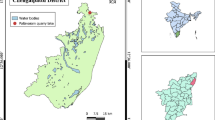Abstract
Nitrate reductase (NR) activity and nutrient (N, P) recycling in the ciliatesColpoda steinii andStylonychia sp. and two unidentified flagellates (I and II), isolated from Lake Kinneret, have been studied. When grown on a bacterium also isolated from the lake, all species, except flagellate I, exhibited NR activity. Activity was higher in the presence of nitrate than in its absence, and in the case ofC. steinii showed a dependence on initial ambient NO3 concentrations in the cultures. NR activity was inversely proportional to body size, suggesting that the larger protozoan species have decreased specific metabolic rates. A net increase in ammonium concentrations and a decrease in orthophosphate levels was observed, but both phenomena were much less sensitive to ambient NO3 concentrations than NR activity. Similar trends in NR activity and NH4 production were also observed whenC. steinii was grown on the picocyanobacteriumSynechococcus sp. Our results suggest that NH4 excretion is the outcome of N remineralization from the food supply but is also partially due to dissimilatory nitrate reduction. These data imply that protozoa may have an important role in nutrient recycling in Lake Kinneret and that some species could use NO3 respiration in anoxic regions of the water column.
Similar content being viewed by others
References
Andersen OK, Goldman JC, Dennet MR (1986) Nutrient cycling in a microflagellate food chain. III. Phosphorus dynamics. Mar Ecol Prog Ser 31:47–55
Andersson A, Lee C, Azam F, Hagstrom A (1985) Release of amino acids and inorganic nutrients by heterotrophic marine microflagellates. Mar Ecol Prog Ser 23:99–106
Azam F, Fenchel T, Field JG, Meyer-Reil LA, Thingstad T (1983) The ecological role of water column microbes in the sea. Mar Ecol Prog Ser 10:257–263
Beaver JR, Crisman ThL (1989) The role of ciliated protozoa in pelagic freshwater ecosystems. Microb Ecol 17:111–136
Berman T (1991) Protozoans as agents in planktonic nutrient cycling. NATO-ASI Ser G25: 417–429
Berman T, Sherr BF, Sherr E, Wynne D, McCarthy JJ (1984) The characteristics of ammonium and nitrate uptake by phytoplankton in Lake Kinneret. Limnol Oceanogr 29:287–297
Bick H (1972) Ciliated protozoa. World Health Organization, Geneva
Caron DA (1989) Evolving role of protozoa in aquatic nutrient cycles. Proc NATO-ASI Workshop, Plymouth, UK, pp 387–415
Fenchel T (1986) The ecology of heterotrophic microflagellates. Adv Microb Ecol 9:57–97
Finlay BJ, Span ASW, Harman JMP (1983) Nitrate respiration in primitive eukaryotes. Nature 303:333–336
Goldman JC, Caron DA (1985) Experimental studies on an omnivorous microflagellate: Implications for grazing and nutrient regeneration in the marine microbial food chain. Deep-Sea Res 32:899–915
Goldman JC, Caron DA, Andersen OK, Dennett MR (1985) Nutrient cycling in a microflagellate food chain: Nitrogen dynamics. Mar Ecol Prog Ser 24:231–242
Goldman JC, Caron DA, Dennett MR (1987) Nutrient cycling in a microflagellate food chain. IV. Phytoplankton-microflagellate interactions. Mar Ecol Progr Ser 38:75–87
Hadas O, Pinkas R, Albert-Diez C, Bloem J, Cappenberg T, Berman T (1990) The effect of detrital addition on the development of nanoflagellates and bacteria in Lake Kinneret. J Plank Res 12:185–199
Hochman A, Nissany A, Wynne D, Kaplan B, Berman T (1986) Nitrate reductase: An improved assay method for phytoplankton. J Plank Res 8:385–392
Jones GJ (1979) Microbial nitrate reduction in freshwater sediments. J Gen Microbiol 115: 27–35
Krul JM (1976) Dissimilatory nitrate and nitrite reduction under aerobic conditions by an aerobically and anaerobically grownAlcalingens sp. and by activated sludge. J Appl Bact 40: 245–260
McFarlane GT, Herbert RA (1982) Nitrate denitrification byVibrio spp. isolated from estuarine sediments. J Gen Microbiol 128:2463–2468
Madoni P (1990) The ciliated protozoa of the monomictic Lake Kinneret (Israel): Species composition and distribution during stratification. Hydrobiologia 190:111–120
Meiberg JBM, Bruinberg PM, Harder W (1980) Effect of dissolved oxygen tension on the metabolism of methylated amines inHyphomicrobium X in the absence and presence of nitrate: Evidence for aerobic denitrification. J Gen Microbiol 120:453–463
Moss B (1972) The influence of environmental factors on the distribution of freshwater algae: An experimental study. I. Introduction and the influence of calcium concentrations. J Ecol 60:917–932
Pomeroy LR (1980) Microbial affects of aquatic food webs. Microbiology 325–327
Porter KG, Feig YS (1980) The use of DAPI for identifying and counting aquatic microflora. Limnol Oceanogr 25:943–948
Psenner R, Shlott-Idl K (1985) Trophic relationship between bacteria and protozoa in the hypolimnion of a meromictic mesotrophic lake. Hydrobiologia 121:111–120
Robertson LA, Kuenen JG (1984) Aerobic denitrification a controversy revived. Arch Microbial 139:351–354
Serruya C (ed.) (1978) Lake Kinneret, Monographiae Biologicae, vol 32. Dr. W. Junk Publishers, The Hague
Sherr BF, Sherr EB (1984) Role of heterotrophic protozoa in carbon and energy flow in aquatic ecosystems. In: King MJ, Reddy CA (eds) Current perspectives in microbial ecology. American Society of Microbiology, Washington, DC, pp 412–423
Sherr EB, Sherr BF, Paffenhofer GA (1986) Phagotrophic protozoa as food for metazoans: A missing trophic link in marine pelagic food webs? Mar Microb Food Webs 1:61–80
Sieburth JMcN (1984) Protozoan bacterivory in pelagic marine waters. In: Hobbie JE, Williams PJ LeB (eds) Heterotrophic activity in the sea. Plenum Press, New York, pp 405–444
Solorzano L (1969) Determination of ammonia in natural waters by the phenol-hypochlorite method. Limnol Oceanogr 14:799–801
Standard methods for the examination of water and wastewater (1985) 16th ed. APHA, AWWA, WPCF
Wynne D, Berman T (1990) The influence of environmental factors on nitrate reductase activity. I. Field studies. Hydrobiologia 194:235–245
Zhender AJB (ed) (1988) Biology of anaerobic microorganisms. Wiley Interscience Publication, New York, pp 1–38
Author information
Authors and Affiliations
Additional information
Offprint requests to: O. Hadas.
Rights and permissions
About this article
Cite this article
Hadas, O., Pinkas, R. & Wynne, D. Nitrate reductase activity, ammonium regeneration, and orthophosphate uptake in protozoa isolated from Lake Kinneret, Israel. Microb Ecol 23, 107–115 (1992). https://doi.org/10.1007/BF00172633
Received:
Revised:
Issue Date:
DOI: https://doi.org/10.1007/BF00172633




